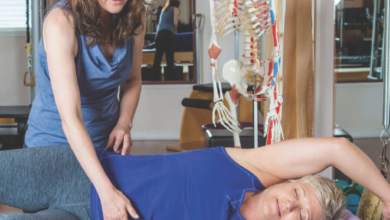Posturally Restorative Pilates Asymmetrical Exercise Makes All the Difference
It’s common for people to believe that what’s good enough for one side of the body must be good enough for the other. The truth is no one is symmetrical! In fact, it is a system of specific imbalances that make the human body so unique. For example, the torso is balanced with the heart on the left and the liver on the right. And reciprocal function balances the extremities; when we walk, the dominant leg moves with the opposite arm. When we exercise, it is important to not assume that the right side of the body needs the same type of movement as the left to stay balanced. The problem is, most exercise and rehab programs are designed to work both sides of the body equally. In my experience, this can be problematic.
My training with the Postural Restoration Institute® helps me recognize imbalances and dysfunctional movement patterns that develop as a result of musculoskeletal weakness or overuse. The way you stand, the curve of your spine, even how the soles of your shoes wear over time indicate the way your body is influenced by asymmetrical movement patterns. The solution is to address these patterns individually, which is why one-size-fits-all symmetrical exercise programs often don’t work.
Posturally Restorative Pilates classes are a great way to address chronic pain aggravated by activity. I’ve developed a unique exercise class that integrates the innovative neuromuscular retraining of Postural Restoration with the core strengthening and balancing of Pilates. Classes are very small and use the reformer, a piece of equipment that maximizes the efficacy of the workout. While classical Pilates would suggest the same exercises are appropriate for both sides of the body, I work with each client to create a customized program that addresses the postural asymmetry specific to each individual. You don’t have to live with chronic pain. Visit our website to learn more about Posturally Restorative Pilates and how we can work together to address what’s really causing the problem.

